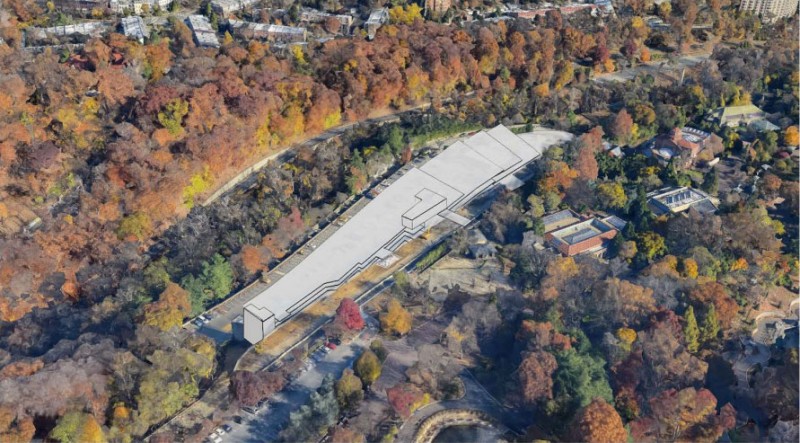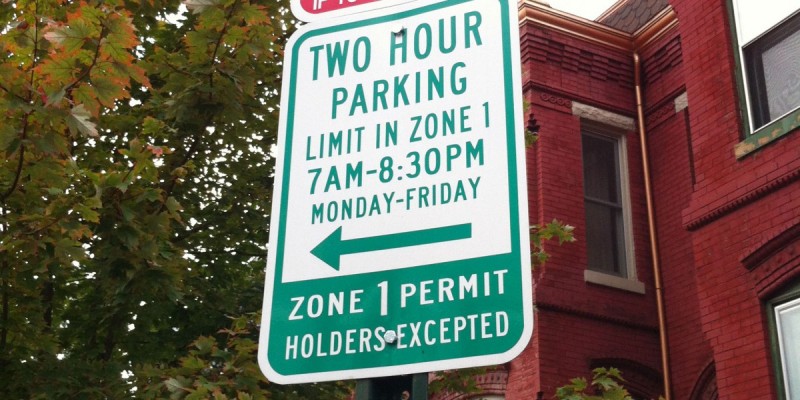The National Zoo cancels its parking garage. What are better ideas?

Formerly-proposed garage rendering by Smithsonian.
The National Zoo won't build a 1,451-space, $50 million parking garage after all. Despite getting federal approval for the concept in 2017, Zoo officials told Michael Neibauer of the Washington Business Journal they have decided to cancel the project because further analysis shows they are “not going to get the revenue [they] hoped for from a parking garage.”
This is good news, because a parking garage would simply draw more driving and more traffic.
However, it is indeed a bit too hard to get to the Zoo. And sadly, Metro has not provided reliable service on weekends. Perhaps because of this, Neibauer previously reported, more visitors drove to the zoo in 2016 than in any of the previous five years. According to a transportation study, Metro rail and bus usage fell to 29% during the study period from 47% in 2015 and 35% in 2014. Ouch.
What else could the zoo do?
For ideas, we could look to the Transportation Demand Management (TDM) plan that starts on page 70 here. The Zoo's consultants put together strategies for increasing non-auto access to the Zoo as a mitigation. But without the garage, many of those ideas are even more valuable.
Bus to the Metro: The Zoo has a shuttle bus which connects the top and bottom ends of the long walkway. The TDM plan says they were considering extending the shuttle to the Cleveland Park Metro. Alternatively, it says, the Zoo was talking to WMATA about adding bus stops and to DC about extending the existing Circulator that ends at Woodley Park up to the Zoo (but this would require building a bus turnaround near the Connecticut Avenue entrance).
Manage the parking demand: The current parking lots “fill to capacity by mid-day on approximately 100 days per year,” according to the NCPC presentation. Full parking lots mean the Zoo isn't effectively allocating the spaces and could be charging more (getting more revenue).
The TDM report recommends the Smithsonian eliminate free parking for zoo employees, as a start. NCPC's federal government standards call for one space per four employees for facilities like the Zoo. The report says the Zoo “will charge for parking at similar rates to what [the Smithsonian] charges downtown and there will be a points system for eligibility based on seniority, vehicle fuel type and carpooling, combined with consideration of special needs.”
For $84 a year, Zoo members receive unlimited free parking. That's an appealing perk for paying to join a free zoo, but free parking encourages extra driving. In 2011, the Smithsonian's Inspector General suggested restricting the parking benefit, such as giving members a fixed number of free parking days instead of unlimited.
DC parking by Wayan Vota.
If parking lots fill up or become more expensive, that may push drivers to look for parking in adjacent neighborhoods. For that matter, they do it anyway, Right now, residential street parking offers anyone two free hours, and on most blocks, unlimited free parking on weekends.
Instead, DC could require people who don't have Ward 1 permits (or permits for a smaller area, ideally) to pay using the Parkmobile pay-by-phone system for parking in what's now the 2-hour grace period and the free weekends.
The presentation says the Smithsonian did explore – but rejected – ideas like offering overflow parking at nearby hotels. Unfortunately, those garages are heavily used on weekends and charge even more for parking (the Marriott Wardman Park charges $45 a day; the Omni Shoreham, $49 for 2 hours or more.)
Possible bus route by Google Maps.
A shuttle to Columbia Heights?
How about this: The Zoo extend its shuttle (and add a second bus on the route) not to Cleveland Park or Woodley Park, but to Columbia Heights. It's a little farther — 1.5 miles for a route connecting all three stops, instead of 1.2 for one using Cleveland Park.
However, in addition to providing Metro access, a Columbia Heights shuttle stop would give people access to a large, mostly empty, cheap parking garage at the DC USA shopping center. DC paid a lot to build that garage, but Target and the other stores vastly overestimated the share of their customers who would drive.
The parking lots on site at the Zoo could be the premium lots, charging a higher rate. Friends of the National Zoo members could get a few coupons for the premium lots a year, but not unlimited. The DC USA garage could be the lower-cost parking option. And then there's Metro, at least when it's operating well.
Keep people from parking in the nearby residential areas by charging people without a proper zone sticker for parking. Let immediate residents keep parking for free and give them a number of coupons for guests.
And after a morning at the zoo, families could return to Columbia Heights and eat a hearty brunch, generating more tax revenue for the District.
The DC government (which owns the DC USA garage) could work out an arrangement with the Zoo to use some of the new parking revenue to help cover shuttle bus costs.
Or, there's an old 2008 aerial tram idea. What do you think about this and other ideas for the Zoo transportation?
